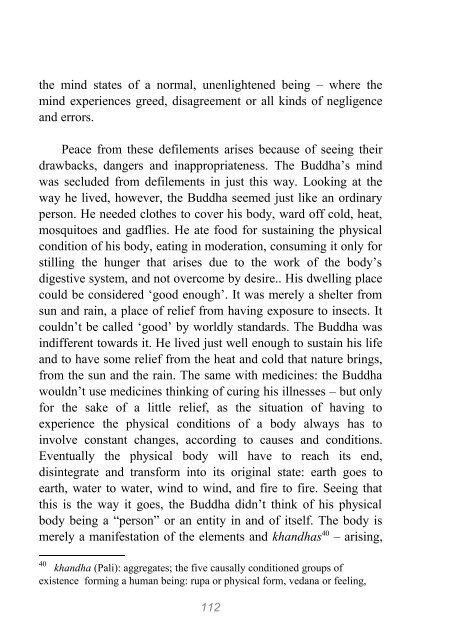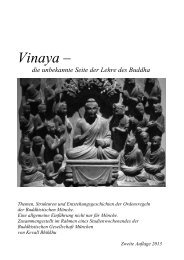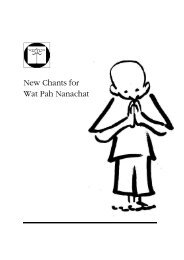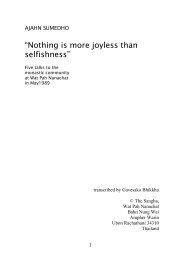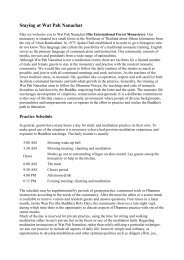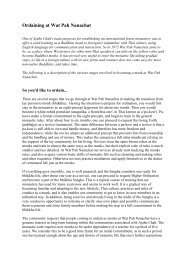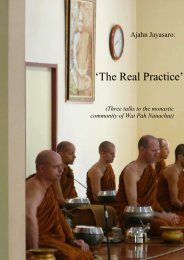Luang Por Liem: The Ways of the Peaceful - Wat Pah Nanachat
Luang Por Liem: The Ways of the Peaceful - Wat Pah Nanachat
Luang Por Liem: The Ways of the Peaceful - Wat Pah Nanachat
Create successful ePaper yourself
Turn your PDF publications into a flip-book with our unique Google optimized e-Paper software.
<strong>the</strong> mind states <strong>of</strong> a normal, unenlightened being – where <strong>the</strong><br />
mind experiences greed, disagreement or all kinds <strong>of</strong> negligence<br />
and errors.<br />
Peace from <strong>the</strong>se defilements arises because <strong>of</strong> seeing <strong>the</strong>ir<br />
drawbacks, dangers and inappropriateness. <strong>The</strong> Buddha’s mind<br />
was secluded from defilements in just this way. Looking at <strong>the</strong><br />
way he lived, however, <strong>the</strong> Buddha seemed just like an ordinary<br />
person. He needed clo<strong>the</strong>s to cover his body, ward <strong>of</strong>f cold, heat,<br />
mosquitoes and gadflies. He ate food for sustaining <strong>the</strong> physical<br />
condition <strong>of</strong> his body, eating in moderation, consuming it only for<br />
stilling <strong>the</strong> hunger that arises due to <strong>the</strong> work <strong>of</strong> <strong>the</strong> body’s<br />
digestive system, and not overcome by desire.. His dwelling place<br />
could be considered ‘good enough’. It was merely a shelter from<br />
sun and rain, a place <strong>of</strong> relief from having exposure to insects. It<br />
couldn’t be called ‘good’ by worldly standards. <strong>The</strong> Buddha was<br />
indifferent towards it. He lived just well enough to sustain his life<br />
and to have some relief from <strong>the</strong> heat and cold that nature brings,<br />
from <strong>the</strong> sun and <strong>the</strong> rain. <strong>The</strong> same with medicines: <strong>the</strong> Buddha<br />
wouldn’t use medicines thinking <strong>of</strong> curing his illnesses – but only<br />
for <strong>the</strong> sake <strong>of</strong> a little relief, as <strong>the</strong> situation <strong>of</strong> having to<br />
experience <strong>the</strong> physical conditions <strong>of</strong> a body always has to<br />
involve constant changes, according to causes and conditions.<br />
Eventually <strong>the</strong> physical body will have to reach its end,<br />
disintegrate and transform into its original state: earth goes to<br />
earth, water to water, wind to wind, and fire to fire. Seeing that<br />
this is <strong>the</strong> way it goes, <strong>the</strong> Buddha didn’t think <strong>of</strong> his physical<br />
body being a “person” or an entity in and <strong>of</strong> itself. <strong>The</strong> body is<br />
merely a manifestation <strong>of</strong> <strong>the</strong> elements and khandhas 40 – arising,<br />
40 khandha (Pali): aggregates; <strong>the</strong> five causally conditioned groups <strong>of</strong><br />
existence forming a human being: rupa or physical form, vedana or feeling,<br />
112


